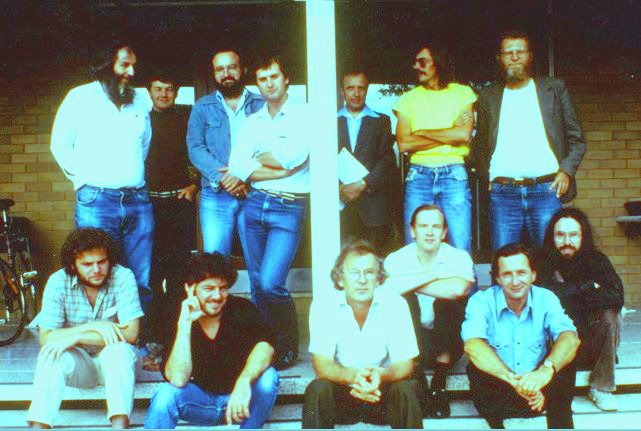I received my PhD in mathematics from the London School of Economics in 1974. It was on (classical) mathematical logic. The topic forced me to think about Gödel’s theorems, and cogitating on these I came to think that certain mathematical arguments forced us to accept contradictions. Clearly this is unacceptable in classical logic, so a paraconsistent logic was required (though I had never heard the name before). I designed to Logic of Paradox, and started to work on its applications. I had more or less finished the paper that bears that name when I moved to Australia in 1976. There I met Richard Sylvan (or Routley as he was then). I was amazed to find out that not only was he thinking along similar lines, but that different paraconsistent logics (as I then learned to call them) had been invented and studied in many countries. We decided to try to bring the various communities together, so we organised the collection of essays Paraconsistent Logic: Essays on the Inconsistent. There was a delay in publishing this, so it didn’t appear till 1989, although it was essentially finished by about 1982. There was also, at the time, much confusion between paraconsistency and dialetheism, the word ‘paraconsistency’ being used for both. (Sometimes ‘strong paraconsistency’ was used for dialetheism.). We needed to make the distinction clear. We couldn’t find a good word, so that’s when we coined the neologism ‘dialetheism’.

2. How did you further develop your work on paraconsistent logic?
I suppose that in the early years, a lot of my work was on systems of paraconsistent logics, and especially relevant logics: looking at their powers and properties. My interest in the subject has always been driven by philosophical considerations, however; and especially dialetheism. So when I wrote In Contradiction, which appeared in 1987, I was able to pull together much of my early work on some of the philosophical applications of dialetheism, and the technical logical machinery supporting them. Since that time, I have acquired may other philosophical interests, but my interests in paraconsistency have continued to develop. On the technical side, I have looked more at the mathematics of the applications of paraconsistent logic, such as in paraconsistent set theory, and the Chunk and Permeate mechanism, which seems to be used in many places in science. On the philosophical side, I have explored the applications of dialetheism to areas beyond those looked at in In Contradiction. A major one of these concerns the contradictions that arise when we explore the limits of our concepts/ language. That was the major theme of Beyond the Limits of Thought, which first appeared in 1995. About that time I also developed an interest in the Asian philosophical traditions, and since then I have been thinking about the applications of dialetheism in Buddhism, in particular. That will be the subjects of the book currently in press, The Fifth Corner of Four. Finally, I suppose, I have written many things in an attempt to popularize paraconsistency and various of its aspects —with essays in handbooks, encyclopedias, etc. My Introduction to Non-Classical Logic (which first appeared in 2001), was an attempt to bring the techniques of non-classical logic to an undergraduate audience. It was not about paraconsistency as such, but sections of the book do introduce the reader to some paraconsistent logics.

3) How do you see the evolution of paraconsistent logic? What are the future challenges?
Over the 40 or so years I have been working on paraconsistency, I have seen many changes: many exciting new developments, ideas, results. One of the most notable changes has been in the general attitude to the subject. In the 1970s, paraconsistent logic was seen as somewhat outrageous: the mere thought that a contradiction might not be the end of the world was enough to ensure this; and dialetheism was considered so absurd as not to be worth a mention. Now, though, paraconsistent logic is a well established field with secure results in semantics, proof theory, algebraicisation—and its own code in the AMS classification. Dialetheism is still a strongly unorthodox view, but at least people can no longer sneer at it. Another change has concerned the size and diversity of the paracosistent community. When we organised the First World Congress on Paraconsistency in Gent in 1996, the community was small enough to have a good number of the active people in the world present. Now, that is no longer possible; and I long ago gave up trying to keep up with all the new developments. So where are we going from here? One can of course only speculate. One thing that seems fairly clear is that the subject is fragmenting into a number of specialities. We will certainly see new developments in the logics themselves, with new logics, and new results about old ones. We will see new work in computer science and artificial intelligence concerning things like data-base management and intelligent reasoning. Serious work on inconsistent mathematics is still, I think, only just starting; but we already know enough to know that there are very interesting inconsistent mathematical structures in set theory, linear algebra, topology, and a number of other areas. I expect to see a lot more of this. Then there are the philosophical applications: in areas such as epistemology, metaphysics, the philosophy of law. There will probably, of course, be developments in hitherto unforeseen areas. One of these might be in science itself, especially when inconsistent mathematics becomes better developed. For the rest, we will have to wait and see. .
